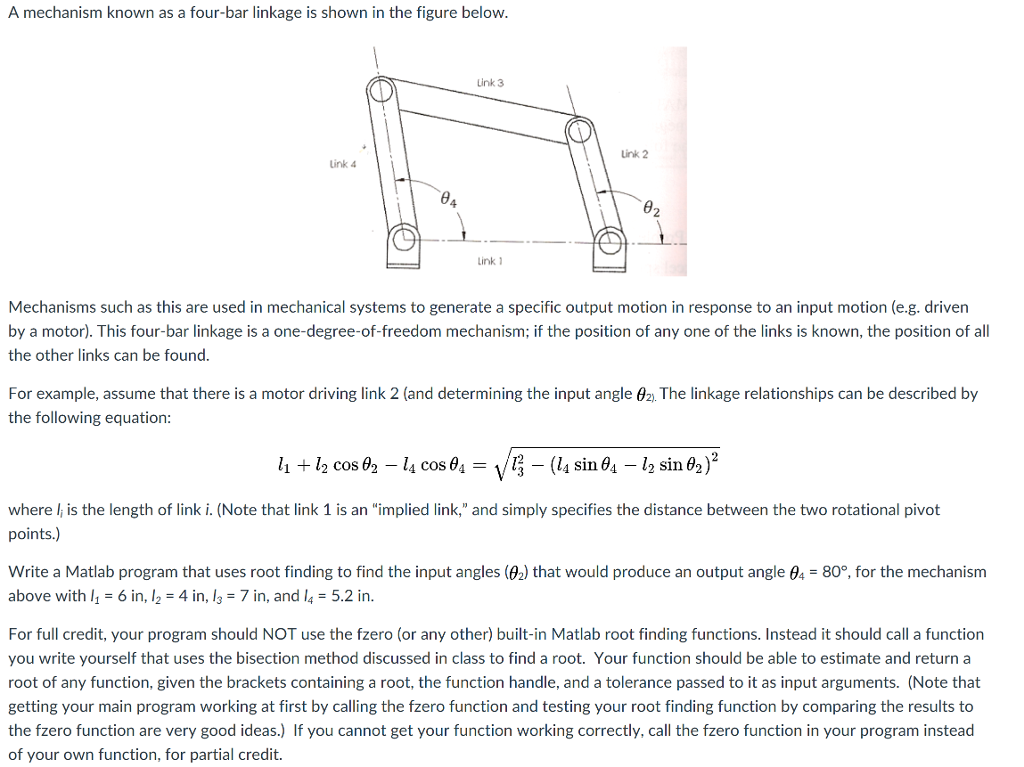
A mechanism known as a four-bar linkage is shown in the figure below. Mechanisms such as this are used in mechanical systems to generate a specific output motion in response to an input motion (e.g. driven by a motor). This four-bar linkage is a one-degree-of-freedom mechanism; if the position of any one of the links is known, the position of all the other links can be found. For example, assume that there is a motor driving link 2 (and determining the input angle theta_2). The linkage relationships can be described by the following equation: l_1 + l_2 cos theta_2 - l_4 cos theta_4 = squareroot l^2_3 - (l_4 sin theta_4 - l_2 sin theta_2)^2 where is the length of link i. (Note that link 1 is an "implied link, " and simply specifies the distance between the two rotational pivot points.) Write a Matlab program that uses root finding to find the input angles (theta_2) that would produce an output angle theta_4 = 80 degree, for the mechanism above with l_1 = 6 in, l_2 = 4 in, l_3 = 7 in, and l_4 = 5.2 in. For full credit, your program should NOT use the fzero (or any other) built-in Matlab root finding functions. Instead it should call a function you write yourself that uses the bisection method discussed in class to find a root. Your function should be able to estimate and return a root of any function, given the brackets containing a root, the function handle, and a tolerance passed to it as input arguments. (Note that getting your main program working at first by calling the fzero function and testing your root finding function by comparing the results to the fzero function are very good ideas.) If you cannot get your function working correctly, call the fzero function in your program instead of your own function, for partial credit. A mechanism known as a four-bar linkage is shown in the figure below. Mechanisms such as this are used in mechanical systems to generate a specific output motion in response to an input motion (e.g. driven by a motor). This four-bar linkage is a one-degree-of-freedom mechanism; if the position of any one of the links is known, the position of all the other links can be found. For example, assume that there is a motor driving link 2 (and determining the input angle theta_2). The linkage relationships can be described by the following equation: l_1 + l_2 cos theta_2 - l_4 cos theta_4 = squareroot l^2_3 - (l_4 sin theta_4 - l_2 sin theta_2)^2 where is the length of link i. (Note that link 1 is an "implied link, " and simply specifies the distance between the two rotational pivot points.) Write a Matlab program that uses root finding to find the input angles (theta_2) that would produce an output angle theta_4 = 80 degree, for the mechanism above with l_1 = 6 in, l_2 = 4 in, l_3 = 7 in, and l_4 = 5.2 in. For full credit, your program should NOT use the fzero (or any other) built-in Matlab root finding functions. Instead it should call a function you write yourself that uses the bisection method discussed in class to find a root. Your function should be able to estimate and return a root of any function, given the brackets containing a root, the function handle, and a tolerance passed to it as input arguments. (Note that getting your main program working at first by calling the fzero function and testing your root finding function by comparing the results to the fzero function are very good ideas.) If you cannot get your function working correctly, call the fzero function in your program instead of your own function, for partial credit







